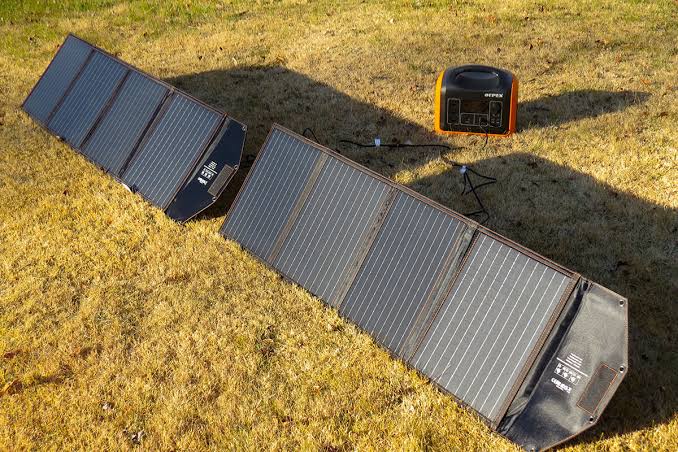Solar energy for camping comes with several benefits of its own, making it a go-to option for many campers. It is a cleaner, environmentally friendlier alternative to gas-powered generators. These units are also compact and silent, making them ideal for use in RVs and vans.
However, especially for new campers, upgrading to solar energy can come with several uncertainties. There are several steps you need to consider, which include figuring out the number of solar panels you will need, the capacity of the generator, and what appliances can you run on a solar generator for camping.
In the following post, we take a deeper look at how you can determine the power output of your solar generator and figure out the appliances you can run on it. Continue reading to find out if investing in a solar generator is worth your time and money or not.
How do solar generators work?
Before figuring out the appliances you can run on a solar generator, here is a brief introduction to how solar generators work.
In a solar generator for camping, you will find the four main parts, i.e., ● Solar panels● Battery● Charge controllers● Inverter
Essentially, the solar panels convert electricity into direct current, which is passed through a charge controller and stored in lithium-ion batteries. The charge controller regulates the current and voltage from the solar panels thereby preventing the battery from overcharging and extending its service lifespan.
When the user needs to use the power, the inverter converts the direct current (DC) into alternating current (AC), which most household appliances use. Portable solar generators can come equipped with AC outlets, USB ports, and other ports that allow you to plug multiple devices simultaneously.
What size solar generator will you need during camping?
The ideal capacity of a solar generator that you will need is proportional to your energy demand during the trip. So, you will need to determine the average energy estimate of your appliances to determine the size of the generator you will need. If you are using an RV, you will need to sum up the power demand of every appliance and adjust for efficiency losses to determine the power capacity.
If you cannot find the wattage, you can calculate it easily by multiplying the voltage and amperage. Once you know the power consumption, multiply it by the duration for which it will be plugged into the generator. For instance, if your laptop will need to run for 6 hrs a day, so the energy demand can be calculated by multiplying the power (W) by the time (6 hrs in this instance).
Once you have calculated the power demand, it is time to purchase a power generator that meets your demands. You will need to find a power generator of a slightly higher capacity to power your appliances. Accounting for efficiency losses ensures that you will not run into a power shortage during a trip.
What can you run on the different capacities of solar generators?
The most common wattages of solar generators are 500W, 1000W, 1500W, and 2000W. Here is a brief summary of what you can run using these.● With a 500W generator, you can easily run televisions, laptops, and power tools with lower TDP. Note that the actual appliances you can run will depend on the power consumption of individual devices.● A 1000W generator can easily run mid-sized appliances like cooking stations, portable fans, coffee makers, desktop computers with slightly higher TDP, etc.● You will need at least 1500W to run electric stoves, refrigerators, and microwave ovens. While a 2000W generator can easily run virtually any appliance like air conditioners and heat pumps, it will not be able to do so simultaneously or for longer durations.
E.g., with a 1000W charger, you can charge your phone about 50 times, laptops about 10 times, cameras about 40 times, and keep your TV running for up to 10 hours.
In an RV, you will need a basic understanding of the electric systems for further installation. The electric system in an RV is either rated for 30 Amps or 50 Amps. Meanwhile, the power available in a 30 Amps unit is around 3600W, while that in a 50 Amps unit can go up to 12000W. However, solar generators usually cannot deliver that kind of power, so you will find power stations with 30 Amps outlets, and you will not be able to run 240V appliances.
A simple workaround in this situation can be plugging the appliances directly into the solar generator. This keeps your RV’s electrical system undisturbed and you can run demanding appliances with ease.
Energy management with solar generators
One of the primary advantages of a solar generator camping is that it is a substantially eco-friendlier alternative to traditional generators. With solar camping, you will need to be smart with how you utilise the power from the solar panels. You might be tempted to run almost anything and everything with your generator, however, it might not be a smart move as you will run out of charge sooner than later.
For light users, you might get by with a smaller solar panel that will keep your smartphones charged and keep the lighting in the tent on for the night. They are a great source of clean energy, can power key appliances during boondocking, and are usually portable. You can find a wide range of solar generators available on the market, meaning you can choose one that best suits your budget and power consumption.
However, you might want to opt for a higher watt solar generator for camping if you do not mind setting up a larger solar panel system, as their higher capacity allows you to have backup power for most of your appliances. Make sure you study your energy requirements to purchase a generator that meets your energy requirements. For more information, get in touch with the experts and they can help you out with further insights.

